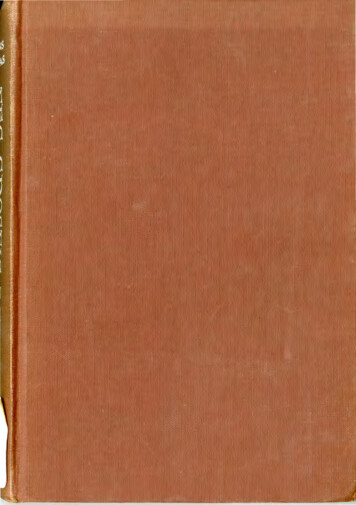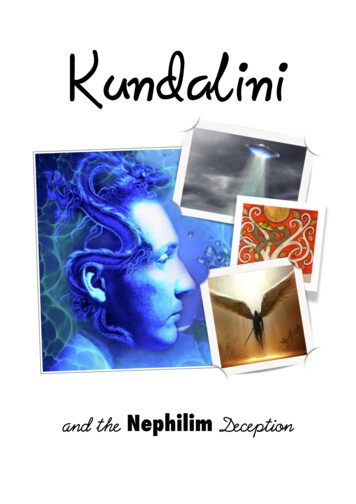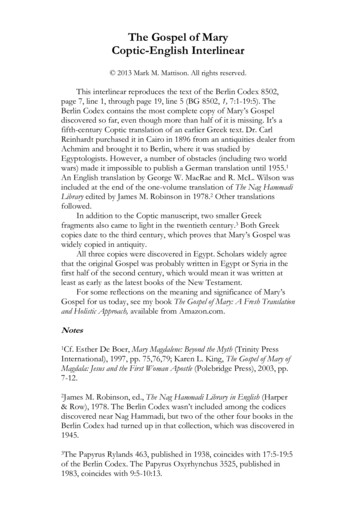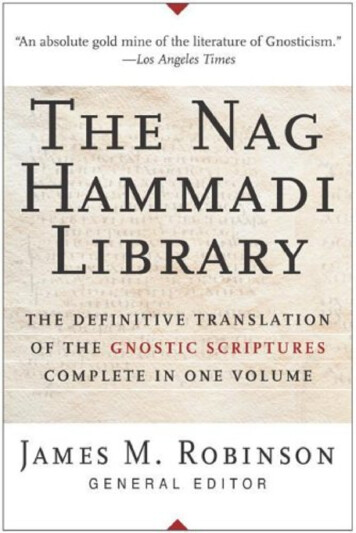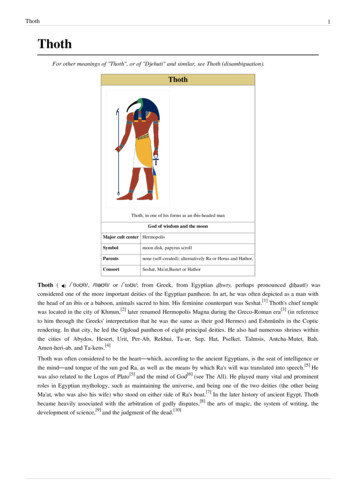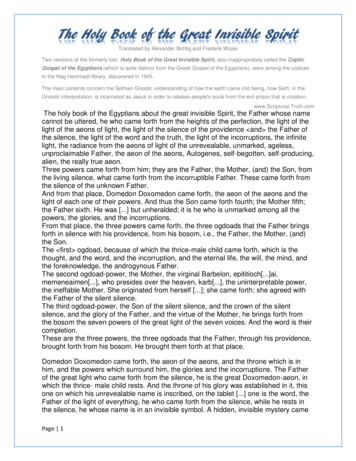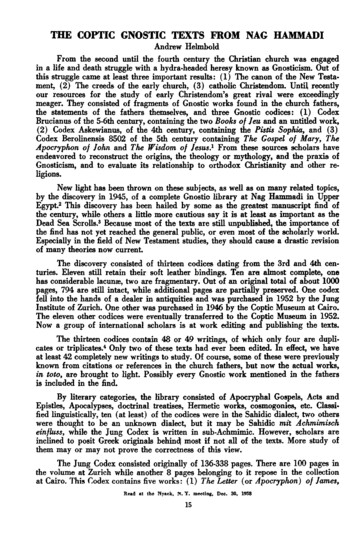
Transcription
THE COPTIC GNOSTIC TEXTS FROM NAG HAMMADIAndrew HelmboldFrom the second until the fourth century the Christian church was engagedin a life and death struggle with a hydra-headed heresy known as Gnosticism. Out ofthis struggle came at least three important results: (1) The canon of the New Testament, (2) The creeds of the early church, (3) catholic Christendom. Until, recentlyour resources for the study of early Christendom's great rival were exceedinglymeager. They consisted of fragments of Gnostic works found in the church fathers,the statements of the fathers themselves, and three Gnostic codices: (1) CodexBrucianus of the 5-6th century, containing the two Books of Jeu and an untitled work,(2) Codex Askewianus, of the 4th century, containing the Pistis Sophia, and (3)Codex Berolinensis 8502 of the 5th century containing The Gospel of Mary, TheApocryphon of John and The Wisdom of Jesus.1 From these sources scholars haveendeavored to reconstruct the origins, the theology or mythology, and the praxis ofGnosticism, and to evaluate its relationship to orthodox Christianity and other religions.New light has been thrown on these subjects, as well as on many related topics,by the discovery in 1945, of a complete Gnostic library at Nag Hammadi in UpperEgypt.2 This discovery has been hailed by some as the greatest manuscript find ofthe century, while others a little more cautious say it is at least as important as theDead Sea Scrolls.3 Because most of the texts are still unpublished, the importance ofthe find has not yet reached the general public, or even most of the scholarly world.Especially in the field of New Testament studies, they should cause a drastic revisionof many theories now current.The discovery consisted of thirteen codices dating from the 3rd and 4th centuries. Eleven still retain their soft leather bindings. Ten arei almost complete, onehas considerable lacunae, two are fragmentary. Out of an original total of about 1000pages, 794 are still intact, while additional pages are partially preserved. One codexfell into the hands of a dealer in antiquities and was purchased in 1952 by the JungInstitute of Zurich. One other was purchased in 1946 by the Coptic Museum at Cairo.The eleven other codices were eventually transferred to the Coptic Museum in 1952.Now a group of international scholars is at work editing and publishing the texts.The thirteen codices contain 48 or 49 writings, of which only four are duplicates or triplicates.4 Only two of these texts had ever been edited. In effect, we haveat least 42 completely new writings to study. Of course, some of diese were previouslyknown from citations or references in the church fathers, but now the actual works,¿τι toto, are brought to light. Possibly every Gnostic work mentioned in the fathersis included in the find.By literary categories, the library consisted of Apocryphal Gospels, Acts andEpistles, Apocalypses, doctrinal treatises, Hermetic works, cosmogonies, etc. Classified linguistically, ten (at least) of the codices were in the Sahidic dialect, two otherswere thought to be an unknown dialect, but it may be Sahidic mit Achmimischeinfhss, while the Jung Codex is written in sub#Achmimic. However, scholars areinclined to posit Greek originals behind most if not all of the texts. More study ofthem may or may not prove the correctness of this view.The Jung Codex consisted originally of 136#338 pages. There are 100 pages inthe volume at Zurich while another 8 pages belonging to it repose in the collectionat Cairo. This Codex contains five works: (1) The Letter (or Apocryphon) of James,Read at the Nyack, N. Y. meeting, Dec. 30, 195815
(2) The Gospel of Truth, (3) The Epistle to Rheginos, (4) The Treatise on the ThreeNatures, (5) Prayers of Peter and Paul. Its provenance, unlike the other codices, isfrom the philosophical Gnostics—the Valentinians. In fact, Dr. Quispel thinks TheGospel of Truth was written by Valentinus himself, and his colleague, Dr. Van Unnik,dates it ca. 140 A.D., before Valentinus broke with the church.5 The Gospel of Truthhas been edited and translated into the major scholarly languages6 so it is availablefor study by interested persons (but kept tantalizingly from us by its prohibitivecost!)The Gospel of Truth is not a Gospel, but a homily or treatise. It leans heavilyon the New Testament, not by quotation, but by allusion, drawing frequently fromJohn, Hebrews, and Revelation. It is informed by a Stoic conception of God as theAll. It has no eschatology, no ethics, no Old Testament basis or bias, no harmartiology—only agnoia & plane. It describes Gnosis as a psychological experience, real orimagined, whereby "man is re-established in himself, again remembers himself, andbecomes conscious of himself, of what he really is by nature and origin. In this wayhe knows or reknows himself in God, knows God, and becomes conscious of himselfas an efHuence from God and a stranger in the world. He thus; acquires, with thepossession of his 'ego' and his true and ontological being, the meaning of his destinyand the final certainty of his salvation, thus discovering himself as a being who, byright and for all eternity, is saved."7 Man is saved by the coming of a redeemerwho is the manifestation of Truth, who abolishes ignorance. No wonder Irenaeustook up the cudgels (Adv. Haer. Ill, 11, 9) against such an incomplete if not totallyfalse gospel.The recovery of this text overthrows two theories previously advanced. JohannesKreyenbuhl proposed in 1900 in Das Evangelium der Wahrheit. Neue Losung derjohanneischen Frage. 2 vol. that the canonical Gospel oí John is identical with TheGospel of Truth. Although the Gnostic work borrows from the Fourth Gospel, it istotally different in content and spirit. The other theory of G. A. van ben Eysinga isto the effect that the canonical Gospels are the "outcome of an historicization of anun-historical Gnostic Alexandrian Gosepl."8 Somewhat of "demythologization" inreverse! However, the recovered Gospel of Truth shows that the process flows theother way—the Gnostic works being dependent upon the canonical Gospels.The Gospel of Truth shows that Valentinus derived his system from the NewTestament, not from Pythagoras and Plato, as Hippolytus supposed (vi. 16). However, it presents Valentinianism in its formative stages, not in its full-blown development.The Apocryphon of James has been discussed by Drs. Puech and Quispel inVigilae Christianae, viii. (1954) and more recently in the same periodical (vol x,1956) by Van Unnik, professor of New Testament Exegesis at Utrecht. The latterholds that it is not Gnostic at all, but simply unreflecting, vague Christianity. Hedates it ca. 125-150 A.D. He finds in it relationships to the Ascensions of Isaiah. Itclaims to be a letter written by the Lord's brother to an unknown person and contains revelations made to Peter and James by Christ before His ascension. It describesitself as an "apocryphon", i.e., good tidings reserved for the inner circle. This groupis described in The Gospel of Truth as the "perfect," the Divine "Seed," the "Childrenof God," etc. The Letter, like many of the writings, is a translation from a Greekoriginal. It opens with the common formula of Greek epistles.Besides the Jung Codex, Doresse lists only one other work as written in subAchmimic.9 However, other scholars have taken two codices to be in an unknowndialect. There is a corpus of Hermética in Codex XI (Doresse, Codex V I ) . The re16
mainder of the texts are all Sethian, i.e., Barbelo-Gnostic. This is the vulgar Gnosticism which was Christianity's great foe in the early centuries.Unfortunately, aside from The Gospel of Truth, the only other texts publishedto date are those reproduced photographically in the Coptic Gnostic Texts in theCoptic Museum at old Cairo, Vol. I. This contains the last two pages of the Discourseof Rheginos concerning the Resurrection lost from the Jung Codex, six other pagesfrom that codex, some fragments from another codex, and five of the seven workscontained in Codex III (Doresse, Codex X). They are: The Apocryphon of John,The Gospel of Thomas, The Gospel of Phillip, the Hypostasis of the Archons (i.e., theBook of Noria), and an untitled book devoted to Pistis Sophia. At present the Gospelof Thomas is being edited and translated and will be available next year. The scholarswho are working on the text report that it is not identical with the Apocryphal Gospel of that name, but is a complete collection of the Logia of Jesus. Its beginning islike that of Oxyrhynchos Papyrus No. 654. Dr. Quispel now ventures the suggestionthat these Logia may have come from the Gospel of the Hebrews which evidently wasused by Tatian, along with the four canonical Gospels in compiling the Diatessaron.10About half of its 114 Logia are of a type which fit into the jig-saw puzzle of textualcriticism. More anon!The Apocryphon of John has been known from the mention made of it byIrenaeus, ca. 180. In 1895 an actual copy of it was discovered in the Codex Berolinensis 8502. However, the text was never published until Walter Till edited it in 1955.This text agrees with one other contained in the Nag Hammadi corpus (Puech &Doresse #1), but varies considerably from that published by the Coptic Museum,and from the third copy found in the Gnostic library (Puech, Codex #VIII, Doresse,Codex #11). No agreement has yet been reached on the date of the published text,but perhaps a date around 350 A.D. will fit the circumstances. The composition, however, goes back much earlier, as indicated above.This work claims to be a revelation of Jesus to John of the secrets of thisworld, past and future. It very evidently was one of the major works in the Gnostictheology. It has an entire scheme of cosmology replete with the typical Gnostic emanations characterized by the weird names given to them in this work. It presents thetypical Gnsotic dualism with the creation of this world through the Demiurge, i.e.,the God of the Old Testament, called in this work, "Yaldabaoth."With six of the forty-five works now available for scholarly study, what hasbeen presented that has a direct bearing on Christian scholarship at this time? Asidefrom the rather complicated problem of the interrelationship of the various religionsof the early Christian era, i.e., Judaism (both orthodox and heterodox), Gnosticism,Hermeticism, Manichaeism, Mandeanism, Neo-Platonism, etc., on which this corpusthrows considerable light, these texts are of primary value to us because of theirbearing on many theological and critical theories of our time.First of all, it should be pointed out that we can accept the accounts of thechurch fathers as substantially correct in their presentation of gnosticism. For example, Tertullian's report of Valentinus is now confirmed by The Gospel of Truth.Now we can discount the previous discounting of the Fathers as being biased.11Coming to the subject of the canon of the New Testament, we see that all ofthe books of the New Testament, except the Pastoral Epistles, are alluded to in TheGospel of Truth. This means already at 140 A.D. these N.T. books were consideredauthoritative. This is the death blow to any dating of the Gospel of John in the 2ndcentury, since Valentinus used it widely. We note, too, that Hebrews and Revelation,two of the antilegomena, occupy an important place in The Gospel of Truth, showing17
their acceptance in the Western Church at this early date. Not until the time ofIrenaeus do we have as extensive a witness to the books held to be authoritative as wefind 40 years earlier in The Gospel of Truth.The eventual value of these writings for textual criticism cannot yet be assessed. However, if other works are as helpful as The Gospel of Thomas givespromise of being, they should be very important. Quispel rightly points out that theLogia in this work show strong affinities to the so-called Western text of the NewTestament, i.e. Codex Beza (D), the Old Latin, the Syriac Curetonian and SyriacSinaiticus manuscripts. About 150 A.D. Marcion used a widely variant western text.Justin Martyr about the same time used the western text of the Gospels. Now anotherauthority for that text is available. I hope it will not be published too late to be usedin the new International Greek New Testament.Among other examples of the value of the Logia for textual criticism, Quispelcites Logia v#9, relating to the parable of the sower. As Wellhausen had alreadypointed out, it makes more sense to read with the Western text, "some fell UPON theroad." This is what The Gosepl of Thomas reads here. It may come from the ambiguity of the Aramaic 6al 'urba which can be translated on or beside the road.Justin has eis tén ódon. (cf. Black: An Aramaic Approach to the Gospels and Acts)12However, the primary value of these texts to us seems to lie in what theyhave to say regarding the relationship of Gnosticism to Christianity. It has beenthe vogue to trace Christian doctrine, especially that of the fourth Gospel, back toa pre-Christian Gnostic Redeemer, and an Iranian Saved Saviour. These texts shouldanswer once for all, whether or not Gnosticism is basically Iranian dualism. Allindications to date are that neither Harnack ("Gnosticism is the acute Hellenizationof Christianity") nor Reitzenstein(Gnosticism comes form Iranian dualism) werecorrect in their estimates of its origins. Whether or not Robert M. Grant is correctin tracing it to a failure of apocalyptic in Judaism remains to be seen. The Apocrypon of John contains some undoubted Jewish elements, but there are also traces ofEgyptian and Greek ideas as well. What can be clearly seen at this juncture is thatGnosticism was, among other things, a mythologization of the historical facts givenin the Gospels.This is of major importance in the light of Bultmann's theory that the Gospelsmythologize what actually happened in the life and death of Jesus. If he is correct,then Gnosticism is the mythologization of a myth! Bultmann, following Reitzenstein,finds the basis of Johannine Theology in a pre-Christian Gnostic Redeemer. Quispelnow calls this into question, showing that die three pillars of the theory are overthrown: (1) The Iranian Gayomart, (2) Anthropos held captive in matter, (3) TheManichaean doctrine of Urmensch falling and returning once again to his primalstate. All of these, Reitzenstein said, came from Persian religion. Quispel says thefirst is from Pseudo-Platonic Epinomis, the second has been shown by Peterson tobe Jewish Tradition, while these Nag Hammadi texts show that the ManichaeanUrmensch was borrowed from the Gnostics, not from Persia.13In The Gospel of Thomas, Logia ν #65 deals with the parable presentd inLuke 20:9#19, the parable of the husbandman. In the Gnostic work it is completelydifferent from the synoptic version. Yet even in the Gnostic work, the death of theson occupies the central place. As Quispel points out, there is no Hellenistic "myth#ologizing" here. This phenomenon is contrary to the whole methodology of Form!geschickte. Since the parable is in Mark, which is considered to be the earliestGospel and to have been written at Rome, Quispel asks How Telia' (i.e. Jewish18
Christians) and the congregation at Rome could have invented the same story. 14 He concludes by saying, "In a sense The Gospel of Thomas confirms the trustworthiness of the Bible." 1SThis is but a brief introduction to the rich and varied contents of the ancientlibrary from Nag Hammadi. Once again, it seems, the Lord has the Devil at workwheeling stones to build His sanctuary. At any rate, we can agree with Puech'scitation of Exodus 7:3: I will . . . multiply my signs and my wonders in the landof Egypt." 16 17 1.2.3.4.5.6.7.8.9.10.11.12.13.14.15.16.17.Standard text editions of these are : C. Schmidt, Gnostische Schriften in koptischer Sprache aus dem Codex Brucia·nus, TU 8, Leipzig, 1892; C. Schmidt, Pistis Sophia, Coptica II, Copenhagen, 1925; Walter Till, Die GnostischenSchriften des koptischen Papyrus Berolinensis 8502, Berlin, 1955. English translation of the untitled work is doneby Ch. A. Baynes, A Coptic Gnostic Treatise contained in the Codex Brucianus, Cambridge, 1933, and Codex Askewianus is translated by C. Horner, Pistis Sophia, London, 1924. Till's work includes German translations ofthe three texts.Most concise account of the discovery in English is by Victor R. Gold, " T h e Gnostic Library of Chenoboskion,"Biblical Archeologist,XV (1952), p p . 70-88.cf. Arthur Darby Nock, " A Coptic Library of Gnostic Writings,*' Journal of Theological Studies, n.e. IX (1958),pp. 314-324. " T h i s " discovery may fairly be set on a level with that of the Dead Sea Scrools." (p. 315). HenriCharles Puech, "Les Nouveaux Ecrits Gnostiques découverts en Haute'Egypte"Coptic Studies in honor of WalterEwing Crura, Boston, 1950, p p . 91-154 says, "truly one of the most surprising and one of the most important discoveries which have been made in Egypt in the course of recent years." (p. 154) (tr. by present writer).Gold, 16id. gives a partial listing of the texts. For a complete listing see Puech, ibid., or Jean Doresse, Les LivresSecrets des Gnostiques d'Egypte, Paris, 1958. Puech and Doresse disagree on the total number of texts and usedifferent systems for numbering the codices and texts. Till uses a third system in referring to the Apocryphon ofJohn variant text, while the Cairo Museum's volumes of texts use a fourth enumeration!Gilles Quispel, " T he Jung Codex and its Significance," p . 50 of The Jung Codex, tr. and ed. by Frank L. Cross,London, 1955. In addition it contains contributions by Puech, " T h e Jung Codex and the other Gnostic Documentsfrom Nag Hammadi," and W. C. van Unnik, " T h e 'Gospel of Truth' and the New Testament." cf. p . 99, 103f forVan Unnik's dating.Evangelium Veritatis, ediderunt M. Malinine, H. C. Puech, and G. Quispel. Studien aus dem CG. JungInstitut,VI. Rascher Verlag, Zurich, 1956. The volume includes an introduction, 24pp. of plates, transcribed Coptic textwhich facing French translation, German and Euglish translations and indices of Greek and Coptic words.Puech, Jung Codex, p . 29Quispel, Jung Codex, p . 49op cit., p . 166Quispel, " T h e Gospel of Thomas and the New Testament," Vigilae Christianae, XI, p p . 189-207.Van Unnik, Jung Codex, p . 123Quispel, V. C , XI, p . 201Jung Codex, p . 76f.V. C, XI, p . 206V. C, XI, p . 207Jung Codex, p . 34After this paper was prepared, I received word from Cairo Museum that the second volume of photographicallyreproduced texts is now in press. Welcome news indeed !19
(2) The Gospel of Truth, (3) The Epistle to Rheginos, (4) The Treatise on the Three Natures, (5) Prayers of Peter and Paul. Its provenance, unlike the other codices, is from the philosophical Gnostics—the Valentinians. In fact, Dr. Quispel thinks The Gospel of Truth was written
